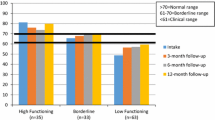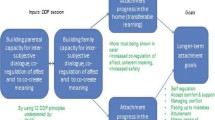Abstract
The focus of this research review is to determine what factors increase the likelihood that positive individual and systemic changes occur for children and adolescents following discharge from residential treatment. Residential treatment outcome studies from 1993 to 2003 that fulfilled predetermined criteria were located through 4 on-line databases using key word combinations. The research selected was: (a) 7 studies that measured outcome immediately upon completion of treatment and discharge, and (b) 11 studies where outcome progress was assessed at one or more follow-up dates after discharge. Results showed that children and adolescents with severe emotional and behaviour disorders can benefit and sustain positive outcomes from residential treatment that is multi-modal, holistic and ecological in its approach. Similar to the clinical child psychotherapy research, conclusions must be tempered due to the limited number of studies and methodological weaknesses. Future considerations highlight how research results can more realistically reflect intervention effectiveness when elements of the ecological and systemic landscape of care are addressed.
Similar content being viewed by others
References
Aarons, G. A., Woodbridge, M., & Carmazzi, A. (2003). Examining leadership, organizationalclimate and service quality in a children's system of care. In C. C. Newman, C. J. Liberton, K. Kutash, & R. M. Friedman (Eds.), The 15th annual research conference proceedings: A system of care for children's mental health: Expanding the research base. (pp. 15–18). Tampa: University of South Florida, The Louis de la Parte Florida Mental Health Institute, Research and Training Center for Children's Mental Health.
Abramovitz, R., & Bloom, S. L. (2003). Creating sanctuary in residential treatment for youth: From the well ordered asylum to a “living-learning environment.” Psychiatric Quarterly, 74, 119–135.
Asarnow, J. R., Aoki, W., & Elson, S. (1996). Children in residential treatment: A follow-up study. Journal of Clinical Child Psychology, 25, 209–214.
Bates, B. C., English, D. J., & Kouidou-Giles, S. (1997). Residential treatment and its alternatives: A review of the literature. Child and Youth Care Forum, 26, 7–51.
Burns, B. J., Hoagwood, K., & Mrazek, P. J. (1999). Effective treatment for mental disorders in children and adolescents. Clinical Child and Family Review, 2, 199–254.
Chamberlain, P. (1999). Residential care for children and adolescents with oppositional defiant disorder and conduct disorder. In H. C. Quay & A. E. Hogan (Eds.), Handbook of disruptive behavior disorders (pp. 495–506). New York: Kluwer Academic/Plenum.
Charles, G., & McIntyre, S. (1990). The best of care: Recommendations for the future of residential services for troubled and troubling young people in Canada. Ottawa, ON: Canadian Child Welfare Association.
Children's Mental Health Ontario (2000, March). Guide to children's mental health programs and services in Ontario 1998/99. Ontario: Author.
Connor, D. F., Miller, K. P., Cunningham, J. A., & Melloni, R. H. (2002). What does getting better mean? Child improvement and measure of outcome in residential treatment. American Journal of Orthopsychiatry, 72, 110–117.
Durrant, M. (1993). Residential treatment: A cooperative, competency-based approach to therapy and program design. New York: W.W. Norton.
Erker, G. J., Searight, H. R., Amanat, E., & White, P. D. (1993). Residential versus day treatment for children: A long-term follow-up study. Child Psychiatry and Human Development, 24, 31–39.
Farmer, E. M. Z., Wagner, H. R., Burns, B. J., & Richards, J. T. (2003). Treatment foster care in a system of care: Sequences and correlates of residential placements. Journal of Child and Family Studies, 12, 11–25.
Frankfort-Howard, R., & Romm, S. (2002). Outcomes of residential treatment of antisocial youth: Development of or cessation from adult antisocial behavior. Residential Treatment for Children and Youth, 19, 53–70.
Frensch, K. M., & Cameron, G. (2002). Treatment of choice or a last resort? A review of residential mental health placements for children and youth. Child and Youth Care Forum, 31, 307–339.
Gorske, T. T., Srebalus, D. J., & Walls, R. T. (2003). Adolescents in residential centres: Characteristics and treatment outcome. Children and Youth Services Review, 25, 317–326.
Greenbaum, P. E., Dedrick, R. F., Friedman, R. M., Kutash, K., Brown, E. C., Lardieri, S. P., & Pugh, A. M. (1996). National adolescent and child treatment study (NACTS): Outcomes for children with serious emotional and behavioral disturbance. Journal of Emotional and Behavioral Disorders, 4, 130–146.
Hernandez, M., Hodges, S., Nesman, T. M., & Ringeisen, H. L. (2001). Findings from the Chinsegut outcomes retreat. In M. Hernandez & S. Hodges (Eds.), Developing outcome strategies in children's mental health (pp. 3–20). Baltimore, Maryland: Paul H. Brookes.
Hendricks, S. (2003, August). Trials and Tribulations of Child and Youth Work? Paper presented at the Finding A Fit: Family Realities and Service Responses, A Child Welfare and Children's Mental Health Conference, Waterloo, Ontario.
Hibbs, E. D. (2001). Evaluating empirically based psychotherapy research for children and adolescents. European Child and Adolescent Psychiatry, 10, 1–11.
Hoagwood, K. (2003a). The evidence for (or against) the evidence: State of science, practice, and policy on children's mental health. Keynote presentation for Best in Show: Evidence-based Practice in Services to Children and Families Conference, September 8–9, 2003. Retrieved June 20, 2005, from http://www.charpp.com/
Hoagwood, K. (2003b). Implementing specific evidence-based practices into complex child and adolescent service systems. Best in Show: Evidence-based Practice in Services to Children and Families Conference, September 8–9, 2003. Retrieved June 20, 2005, from http://www.charpp.com/
Hoagwood, K., & Cunningham, M. P. A. (1992). Outcomes of children with emotional disturbance in residential treatment for educational purposes. Journal of Child and Family Studies, 1, 129–140.
Hooper, S. R., Murphy, J., Devaney, A., & Hultman, T. (2000). Ecological outcomes of adolescents in a psychoeducational residential treatment facility. American Journal of Orthopsychiatry, 70, 491–500.
Hussey, D. L., & Guo, S. (2002). Profile characteristics and behavioral change trajectories of young residential children. Journal of Child and Family Studies, 11, 401–410.
Jacobson, D., & Cervine, D. (2001). A magic growth formula for mental health services in Santa Cruz County. In M. Hernadez & S. Hodges (Eds.), Developing outcome strategies in children's mental health (pp. 115–136). Baltimore, Maryland: Paul H. Brookes.
Kaminsky, I. (1998). An assessment of young men previously in residential treatment: Is the past prologue? Residential Treatment for Children and Youth, 16, 67–82.
Kirby, L. D., & Fraser, M. W. (1997). Risk and resilience in childhood. In M. W. Fraser (Ed.), Risk and resilience in childhood: An ecological perspective (pp. 10–33). Washington, DC: NASW Press.
Kitzhaber. K. (2003). Opening remarks. Best in Show: Evidence-based Practice in Services to Children and Families Conference, September 8–9, 2003. Retrieved June 20, 2005, from http://www.charpp.com/
Landsman, M. J., Groza, V., Tyler, M., & Malone, K. (2001). Outcomes of family-centered residential treatment. Child Welfare, 80, 351–379.
Larzelere, R. E., Dinges, K., Schmidt, M. D., Spellman, D. F., Criste, T. R., & Connell, P. (2001). Outcomes of residential treatment: A study of the adolescent clients of Girls and Boys Town. Child and Youth Care Forum, 30, 175–185.
Leichtman, M., & Leichtman, M. L. (2001a). Facilitating the transition from residential treatment into the community: I. The problem. Residential Treatment for Children and Youth, 19, 21–27.
Leichtman, M., & Leichtman, M. L. (2001b). Facilitating the transition from residential treatment into the community: IV. Making use of community resources. Residential Treatment for Children and Youth, 19, 43–52.
Lonigan, C. J., Elbert, J. C., & Johnson, S. B. (1998). Empirically supported psychosocial interventions with children: An overview. Journal of Clinical Child Psychology, 27, 138–145.
Lyons, J. S., Terry, P., Martinovich, Z., Peterson, J., & Bouska, B. (2001). Outcome trajectories for adolescents in residential treatment: A statewide evaluation. Journal of Child and Family Studies, 10, 333–345.
March, J. S., & Curry, J. F. (1998). Predicting the outcome of treatment. Journal of Abnormal Child Psychology, 26, 39–51.
Ministry of Community and Social Services (1978, September). Children's residential care facilities: Proposed standards and guidelines. Government of Ontario: Children's Services Division.
Nansel, T. R., Raines, S., Jackson, D. L., Teal, C. R., Force, R. C., Klingsporn, M. J., & Burdsal, C. A. (1998). A survey of residential treatment centers' outcome research practices. Residential Treatment for Children and Youth, 15, 45–59.
Noser, K., & Bickman, L. (2000). Quality indicators of children's mental health services: Do they predict improved client outcomes? Journal of Emotional and Behavioral Disorders, 8, 9–18.
Overstreet, D. W., Casel, G., Saunders, T., & Armstrong, M. I. (2001). Florida's use of accountable innovation. In M. Hernandez & S. Hodges (Eds.), Developing outcome strategies in children's mental health (pp. 97–114). Baltimore, Maryland: Paul H. Brookes.
Peterson, M., & Scanlan, M. (2002). Diagnosis and placement variables affecting the outcome of adolescents with behavioral disorders. Residential Treatment for Children and Youth, 20, 15–23.
Pfeiffer, S. I. (1996). Preface. In S. I. Pfeiffer (Ed.), Outcome assessment in residential treatment (pp. xiii–xiv). New York: Haworth Press.
Pratt, S. I., & Moreland, K. L. (1996). Introduction to treatment outcome: Historical perspectives and current issues. In S. I. Pfeiffer (Ed.), Outcome assessment in residential treatment (pp. 1–27). New York: Haworth Press.
Rae-Grant, Q., & Moffat, P. J. (1971). Children in Canada—residential care. Toronto: The Canadian Mental Health Association.
Robins, L. N. (1966). Deviant children grow up: A sociological and psychiatric study of sociopathic personality. Baltimore: Williams & Wilkins.
Rosen, M. (1998). Treating children in out-of-home placements. New York: The Haworth Press.
Shapiro, J. P., Welker, C. J., & Pierce, J. L. (1999). An evaluation of residential treatment for youth with mental health and delinquency-related problems. Residential Treatment for Children and Youth, 17, 33–48.
Stage, S. A. (1999). Predicting adolescents' discharge status following residential treatment. Residential Treatment for Children and Youth, 16, 37–56.
Stroul, B. A. (1996). Profiles of local systems of care. In B. A. Stroul (Ed.), Children's Mental Health: Creating systems of care in a changing society (pp. 149–176). Baltimore, Maryland: Paul H. Brookes.
Stroul, B. A., & Friedman, R. M. (1996). The system of care concept and philosophy. In B. A. Stroul (Ed.), Children's mental health: Creating systems of care in a changing society (pp. 3–21). Baltimore, Maryland: Paul H. Brookes.
Stroul, B. A., Friedman, R. M., Hernandez, M., Roebuck, L., Lourie, I. S., & Koyanagi, C. (1996). Systems of care in the future. In B. A. Stroul (Ed.), Children's mental health: Creating systems of care in a changing society (pp. 591–612). Baltimore, Maryland: Paul H. Brookes.
Sunseri, P. A. (2001). The prediction of unplanned discharge from residential treatment. Child and Youth Care Forum, 30, 283–303.
Taylor, D. A., & Alpert, S. W. (1973). Continuity and support following residential treatment. New York: Child Welfare League of America.
U.S. Public Health Service (2000). Panel 3: State of the Evidence on Treatments, Services, Systems of Care, and Financing. Summary proceedings from the Report of the Surgeon General's Conference on Children's Mental Health: A National Action Agenda. Washington, DC: Department of Health and Human Services. Retrieved June 6, 2005, from http://www.surgeongeneral.gov/topics/cmh/childreport.htm#pan3
Waddell, C., & Shepherd, C. (2002, October). Prevalence of mental disorders in children and youth: A research update prepared for the British Columbia Ministry of Children and Family Development. BC: University of British Columbia.
Weisz, J. R., & Jensen, A. L. (2001). Child and adolescent psychotherapy in research and practice contexts: Review of the evidence and suggestions for improving the field. European Child and Adolescent Psychiatry, 10, 12–18.
Wells, K., Wyatt, E., & Hobfoll, S. (1991). Factors associated with adaptation of youths discharged from residential treatment. Children and Youth Services Review, 13, 1999–216.
Wilmshurst, L. A. (2002). Treatment programs for youth with emotional and behavioural disorders: An outcome study of two alternative approaches. Mental Health Services Research, 4, 85–96.
Zimmerman, D. P. (1996). A comparison of commonly used treatment measures. In S. I. Pfeiffer (Ed.), Outcome assessment in residential treatment (pp. 49–69). New York: Haworth Press.
Author information
Authors and Affiliations
Corresponding author
Rights and permissions
About this article
Cite this article
Hair, H.J. Outcomes for Children and Adolescents After Residential Treatment: A Review of Research from 1993 to 2003. J Child Fam Stud 14, 551–575 (2005). https://doi.org/10.1007/s10826-005-7188-9
Issue Date:
DOI: https://doi.org/10.1007/s10826-005-7188-9




